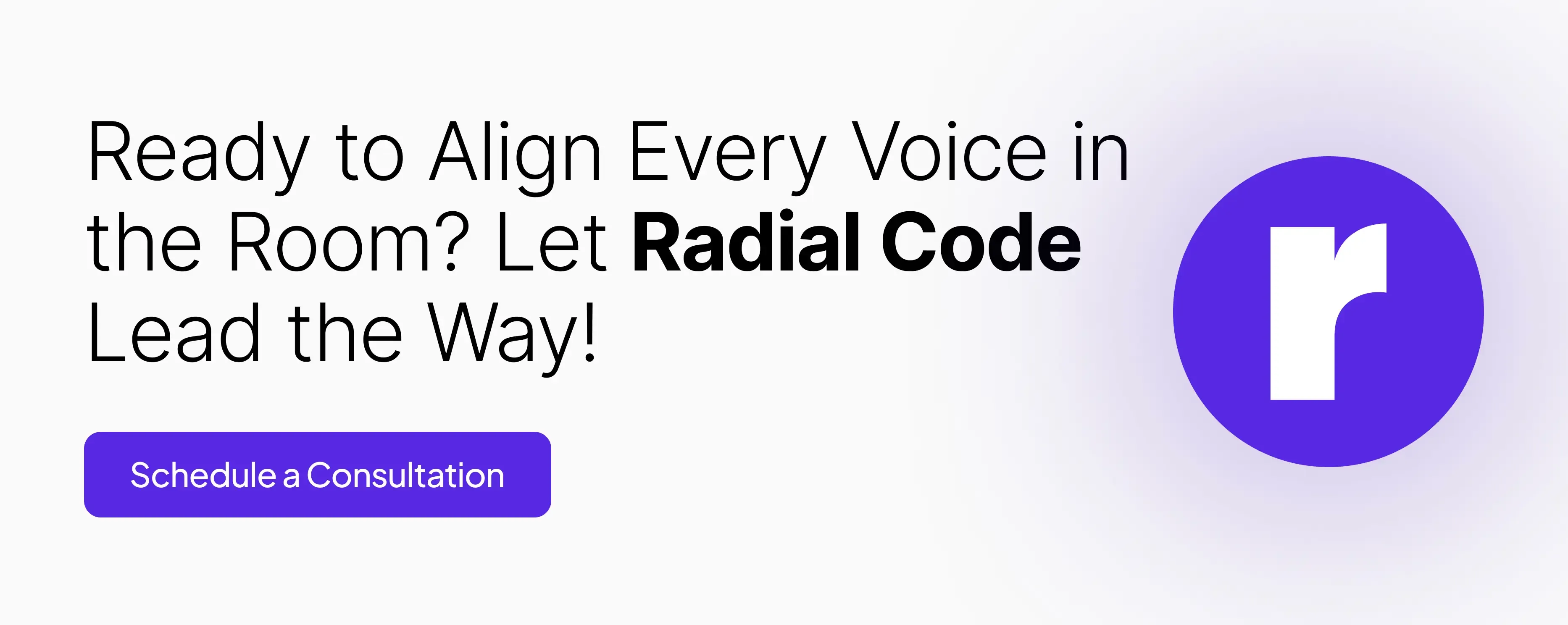Balancing Competing Stakeholder Feedbacks in Design Process

Written by
Vishal Baloda
UI/UX Designer
Sumit Verma
UI/UX Designer
Table of contents
Build with Radial Code
Ever planned a trip with friends? One wants the beach, another prefers the mountains, and someone else insists on a city tour. With so many opinions, making a decision feels impossible! Designing with multiple stakeholders is similar. Everyone has different ideas, from business goals to user experience to technical needs. Conflicting feedback is a common challenge in the design process, but handling it effectively can turn disagreements into valuable insights. But How? Let’s dive in!

What is Feedback, and Why is it Important?
Feedback is the valuable input designers receive from different stakeholders—clients, developers, marketers, and users. It helps identify what’s working, what’s not, and where improvements are needed.
Why it Matters
Feedback plays a crucial role in shaping a successful design. Why does it matter? Let’s break it down.
- Ensures the design meets business and user needs.
- Highlights strengths and areas for improvement.
- Helps maintain technical feasibility.
- Leads to better decision-making.
- Fuels new ideas and improvements through diverse perspectives.
When managed well, it leads to better decisions and a stronger final product. On the other hand, unresolved conflicting feedback can cause delays and confusion.
"Design is everywhere. From the dress you’re wearing to the smartphone you’re holding, it’s design."
-Samadara Ginige, Designer and Developer

Understanding the Sources of Conflicting Feedback
Conflicting feedback arises when stakeholders have different priorities and viewpoints. Understanding these differences is key to managing them effectively.
- Business vs. User Needs: Stakeholders may focus on revenue, while designers prioritize usability.
- Technical Constraints: Developers might flag feasibility issues that clash with creative ideas.
- Marketing vs. UX: Marketers want visually striking elements, but UX designers focus on clarity.
- Personal Opinions: Subjective opinions can create disagreements.
- Unclear Goals: Unclear goals can often provide inconsistent feedback.
By identifying these sources, you can balance input and make better design decisions.

Strategies for Managing Conflicting Feedbacks
Handling conflicting feedback is essential for a smooth design process. Without a clear approach, it can lead to confusion and delays. Here are some strategies to manage conflicting feedback effectively:
- Prioritize Goals: Align feedback with business goals, user needs, and technical feasibility.
- Identify Decision-Makers: Focus on key stakeholders whose feedback matters most.
- Ask for Clarification: Seek further explanation when feedback is unclear or contradictory.
- Facilitate Open Discussions: Encourage direct conversations to align perspectives, resolve conflicts, and find common ground.
- Document Feedback: Keep a clear record to ensure transparency and avoid repetitive issues.
- Educate Stakeholders: Help stakeholders understand design principles to reduce unrealistic requests.
- Know When to Push Back: Confidently reject feedback that compromises usability or design integrity.
By applying these strategies, you can effectively manage conflicting feedback and ensure a more productive design process.

Tools & Techniques for Handling Feedbacks
Managing feedback effectively requires the right tools and techniques. Here are some useful ways to make the process simple:
- Design Collaboration Tools: Platforms like Figma, ClickUp, and Slack allow stakeholders to leave comments directly on designs, making feedback clear and actionable.
- Project Management Tools: Use tools like ClickUp or Loom to track feedback, prioritize tasks, and ensure nothing gets overlooked.
- Version Control & Documentation: Keep track of design iterations and feedback history with tools like Notion, Figma, or Google Docs for transparency.
- Feedback Frameworks: Apply structured techniques like the "What, Why, How" method—identifying what needs improvement, why it matters, and how to address it.
- Facilitated Review Sessions: Host regular design reviews or workshops to discuss feedback in real-time, align stakeholders, and avoid miscommunication.
By using these tools and techniques, you can organize feedback efficiently and ensure a smooth, productive design process.

Common Mistakes to Avoid
Feedback is crucial, but mismanaging it can cause problems. Here’s what to avoid:
- Implementing Every Suggestion: Not all feedback is useful; focus on what aligns with project goals.
- Unclear Design Objectives: Unclear goals lead to scattered and inconsistent feedback.
- Not Asking for Clarification: Misinterpreting feedback can result in unnecessary revisions.
- Delaying Feedback Integration: Delaying Feedback Integration
- Failing to Document Feedback: Keeping track of feedback ensures transparency and prevents repetitive conflicts.
Conclusion:
Handling conflicting feedback in design is a challenge, but with the right approach, it can become a powerful tool for improvement. By understanding the sources of feedback, prioritising goals, facilitating open discussions, and using the right tools, designers can turn disagreements into valuable insights. The key is to strike a balance between business objectives, user needs, and technical feasibility while maintaining clarity and consistency throughout the process. When managed effectively, feedback fosters collaboration, enhances design quality, and leads to better decision-making. Instead of seeing conflicting feedback as a hurdle, embrace it as an opportunity to refine and strengthen your design.
